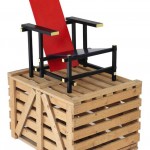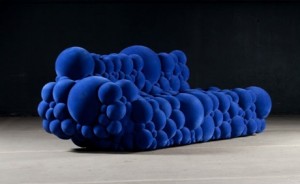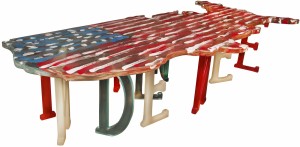
Design Miami: Youthful Vibe, Design Orthodoxy, and Liminal Spaces
The annual design and limited-edition furniture fair Design Miami was held in a vinyl tent inside the parking lot of the Art Basel Miami Beach convention center. An easy hop skip and jump past the waiting taxis, put me under the huge balloon sculpture, “Drift,” designed by the collaborative team Snarkitechture: Alex Mustonen, an architect, and Daniel Arsham, an artist. The balloons gave the entry a carnival-like atmosphere and reminded me a little of Gaudi’s stone stalactites in Guell Park in Barcelona. There were 20 or so satellite fairs during Art Basel, and Design Miami was the only fair with an exterior treatment. Some of the others had set up lovely interior oases to lounge in, but this playful cave-like gateway was welcoming and visually stunning.

A Rietveld chair shown with its original shipping crate
Design Miami, unlike Art Basel, was full of young people. A large group had formed waiting for rapper/singer/producer/composer/designer Pharrell Williams to appear. To sign his book, The Places and Spaces I’ve Been, Pharrell showed up dressed in a natty camo shorts suit (watch the interview with Craig Robins of Design Miami here). I found myself standing next to Kanye West, who emerged to ask a question of the young impresario, prompting a barrage of cell-phone photos.

Armoire Chinoise by Vincent Dubourg
The fair was a lively mix of vintage and new design. Galerie VIVID from Rotterdam showed an unused Rietveld Red Blue chair with its original shipping crate. The chair had been ordered by an architect in 1965 but had never made it to America, and had been in storage since then. Amid the residual design orthodoxy (plenty of Eameses and Prouvés on view), I was drawn to the numerous pieces floating in liminal space between art and function, such as “Armoire Chinoise” by Vincent Dubourg, at Carpenters Workshop Gallery, London and Paris. All pieces in the fair, no matter how decorative or whimsical, are required to be functional.

Maarten De Ceulaer’s Mutation Series Sofa at Industry Gallery
Use of unusual materials proliferated. Industry Gallery, with locations in Washington, DC and Los Angeles, showed tables created from shredded paper in resin, designed by Jens Praet. Craig Appelbaum, the gallery owner, said the paper was actually shredded issues of Elle Décor, and that the tables would be featured in the magazine. Industry also presented chairs made from brightly colored foam and rubber balls, designed by Maarten de Ceulaer, that looked like they could have bubbled up from a toxic well.

The late Robert Loughlin’s trademark iconography at Johnson Trading Gallery
The Johnson Trading Gallery exhibited a series of charming pieces by the late Robert Loughlin, artist and “picker,” who was well-known for creating a market for mid-century and forgotten era pieces, scouring flea markets, then selling them to dealers, first from his own shop and then from his pick-up truck. The booth featured a wall-text ode to gallery owner Paul Johnson’s friendship with Loughlin, who was a fixture in the East Village in the ’80s, developing his standard character, a square-jawed man with a cigarette dangling from his lips, which he painted wherever he could, including on some of the furniture that had gone unsold. Johnson Trading Gallery is the only one that exhibited in both the design fair and Art Basel.
 Mondo Cane of New York showed the work of a Minneapolis design collective, RO/LU, with a strong nod to Donald Judd. I spoke to Matt Olson, who was there representing the group, about chairs, sitting, blindness, and gravity. The group’s roots are in landscape architecture, and their interest in place evolved into a broader investment in discourse on the act of making in general. They don’t self-identify as designers, architects or artists, taking an open-ended approach to installation, design and social media. The furniture pieces are of unfinished plywood, based on systemic geometry, and suggest a dialogue between prefab, ad hoc shelter and high concept. Prices range from around $1700 to almost $20,000 for a large shelf unit.
Mondo Cane of New York showed the work of a Minneapolis design collective, RO/LU, with a strong nod to Donald Judd. I spoke to Matt Olson, who was there representing the group, about chairs, sitting, blindness, and gravity. The group’s roots are in landscape architecture, and their interest in place evolved into a broader investment in discourse on the act of making in general. They don’t self-identify as designers, architects or artists, taking an open-ended approach to installation, design and social media. The furniture pieces are of unfinished plywood, based on systemic geometry, and suggest a dialogue between prefab, ad hoc shelter and high concept. Prices range from around $1700 to almost $20,000 for a large shelf unit.
European galleries seemed to be in the majority, so seeing Gaetano Pesce’s 11-foot America Table at EraStudio Apartment-Gallery in Milan was a crowd pleaser. The gallerist told me it was an homage to Thomas Jefferson, “because he wrote the Declaration of Independence.” Well, he was a designer and architect, so I guess he can be singled out in this context. Built from resin, the top was a map of the US with an image of the flag embedded; the legs were letters spelling “independence.”
Over the years I’ve often thought about Betsy Ross, and how her practical design has proven to be such a powerful and versatile graphic. Designers can change the materials, bend the rules of function, conceptualize, bring in humor and play, but even some of the finest practitioners can rely on eternal symbols and well-worn forms. Still, I found Design Miami to be a lot more fun than its neighbor across the parking lot.

Gaetano Pesce’s America Table. The designer is 73, and still at the front of industrial remixes. This 11-foot resin table sold for $155,000 from a Milan gallery, Era-Studio Apartment. Photo: Pier Nicola Bruno
